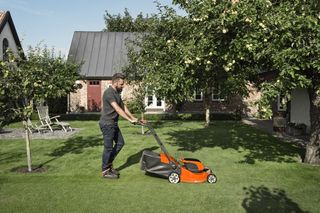How to mulch grass and leaves
Mulching your lawn with grass and leaves can save you time as well as money. Here are our best tips when mulching your lawn with grass cuttings and leaves.
| Effects of mulching |
|---|
There are many positive effects of mulching grass and leaves, such as saving time and money as well as in the quality and look of your lawn. Here’s a list of the perks of mulching:
|
When to mulch
Mulching should only be done when there is active micro life in the soil. That means that the temperature in the surface layer of your soil should be at least 6 degrees Celsius. If mulching is done regularly when the grass is not growing, for instance during the warm summer months or late in the autumn if you live where seasons change, there will be little or no decomposition. Consequently there will be a greater risk of thatch development.
Mulching grass clippings
Grass remains contain 80 to 85% water, which makes it decompose quickly with low risk of causing thatch, unlike other dead plant remains. The decomposition of grass cuttings occurs most rapidly if only a third of the grass blade length is cut off on each occasion. However, no more than half of the length of the blade should ever be cut, as this would increase the risk of dehydration due to loss of fluid in the plant.
Mulching leaves
When leaf mulching, you can save cost and time if leaves that fall in hedges, flowerbeds and paths are blown onto the open grass areas where a ride-on mower with a mulching unit can chop the leaves up.
When to collect instead
Keep in mind that mulching cannot altogether replace the traditional collection of leaves. Therefore, it’s a good idea to collect the remaining leaves after the last mowing of the season, when the ground temperature is below 6 degrees Celsius and the grass has stopped growing. Otherwise the risk of problems like fungal attacks increases during the winter.
| Leaf mulching in different parts of the world |
|---|
| Depending on climate there are different things to consider when mulching. In northern Europe, for example, it’s important to remember when mulching leaves that only a small proportion of the leaves fall before the first frost, while a large part of it fall soon after. By letting grass grow a few centimetres higher than normal in the autumn, you can – for a short period – mulch more leaf remains, since the mulched remains are concealed in the somewhat taller grass. |













